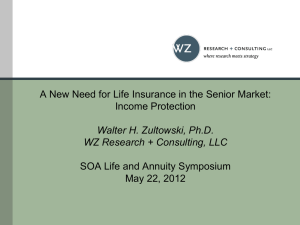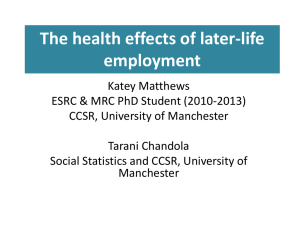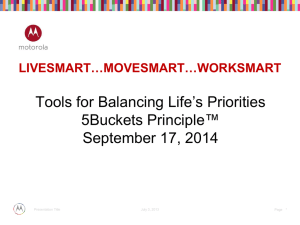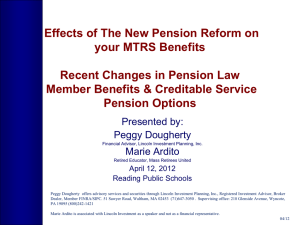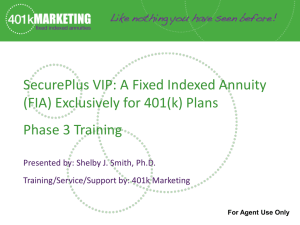Chapter 15 - The University of Texas at Austin
advertisement
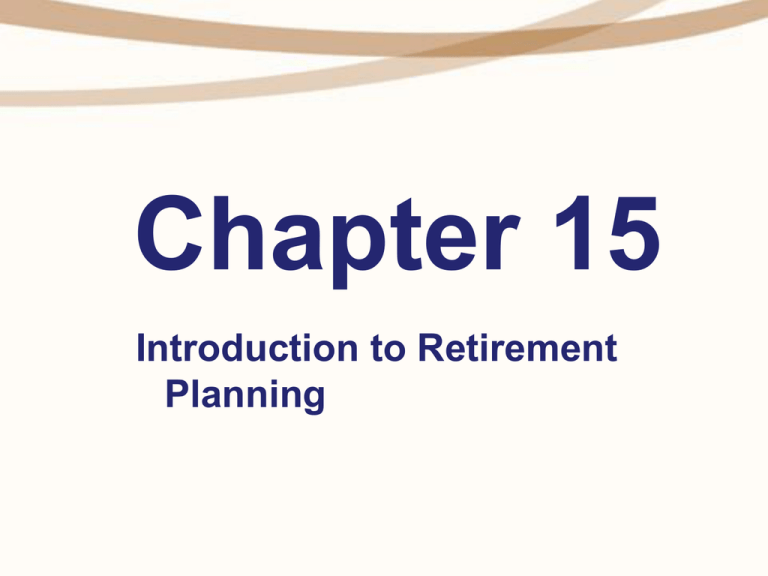
Chapter 15 Introduction to Retirement Planning Retirement Planning One of the main goals for many individuals is long-term financial security and independence This goal is realized when a person is financially secure enough to live at a desired comfort level without the need for employment income 5-2 Basic Factors Affecting Retirement Planning Work life expectancy (WLE) Remaining work life expectancy (RWLE) Retirement life expectancy (RLE) Basic savings concepts Inflation Investment returns Annual income needs Wage replacement ratio (WRR) Retirement income sources Qualitative factors 5-3 Work Life Expectancy Work life expectancy (WLE) is the period a person is in the work force, generally about 30 to 40 years Remaining work life expectancy (RWLE) is the work period that remains at a certain point in time prior to retirement 5-4 Retirement Life Expectancy (RLE) Retirement life expectancy (RLE) is the period beginning at retirement and extending until death The RLE is the period of retirement that must be funded 5-5 Important Savings Concepts in Retirement Planning Savings amount Savings rate Timing of savings Investment decisions Impact of inflation 5-6 Timing of Savings The earlier a person begins saving for retirement, the greater the number of future compounding periods available before retirement The greater number of compounding periods leads to a lower required savings rate and a larger accumulation of capital at retirement 5-7 Defining the Retirement Goal Balancing increasing retirement income needs with decreasing retirement income Planning for retirement—pretax or after tax 5-8 The Wage Replacement Ratio (WRR) The WRR is an estimate of the amount of annual income needed at retirement to properly fund the period called the retirement life expectancy (RLE) The WRR is calculated by dividing the amount of money needed on an annual basis in retirement by the preretirement income 5-9 Calculating the WRR Top-down approach • Used with younger clients where expenditure patterns are likely to change dramatically over time Budgeting approach • Used with older clients because, as a person nears retirement, it is possible to examine the actual expenditure patterns of the person 5-10 The Sources of Retirement Income Social Security Private pension plans Personal savings Work 5-11 Qualitative Factors in Retirement Voluntary versus involuntary retirement Loss of self-esteem Boredom Decision to relocate 5-12 Factors That Negatively Affect Retirement Planning FACTORS IMPACT Reduced WLE Insufficient savings period Increased RLE Increase capital needs Reduced family reliance Fewer alternatives in retirement Reduced ability to work Fewer alternatives in retirement Planned too late Fewer compounding periods Low savings rate Inability to meet capital requirements Inflation Purchasing power reduction Poor earnings rate and asset allocation Inability to meet capital requirements Capital Needs Analysis The process of calculating the amount of investment capital needed at retirement to maintain the preretirement lifestyle and mitigate the effect of inflation during the retirement years Three methods—basic annuity method, the capital preservation model, and the purchasing power preservation model 5-14 Capital Needs Analysis (cont.) Basic annuity method—retirement account has a zero balance at the end of life expectancy Capital preservation model—retirement account at the end of life expectancy is equal to the account balance at the beginning of retirement Purchasing power preservation model— retirement account at the end of the life expectancy has the same purchasing power as the account balance at the beginning of retirement 5-15

